
This year’s Nobel Prize in Physics was awarded to Prof. Andre Geimand and Dr Konstantin Novoselov from the University of Manchester, for their experimental isolation of graphene, a layer of graphite just 1 atom thick (KS Novoselov et al., Science 306, 666 (2004)).
This breakthrough consisted of depositing thin layers of graphite on silicon, then peeling successive atomic layers off with Scotch tape until only 1 layer remained. The technique produces a small number of crystals of monolayer graphene surrounded by a large number of thicker crystallites (see photo), but it was possible to identify the single atomic layers with the naked eye in an optical microscope, provided that the correct thickness of SiO2 had been deposited on the Silicon substrate.
The explosion of scientific interest in graphene which followed was due to its unique electronic bandstructure in which the electrons behave as massless Dirac Fermions, mimicking relativistic particles. The quantum Hall effect and ballistic transport have been observed in graphene at room temperature, leading to its development for a wide variety of applications in electronics. Its high surface-area-to-volume ratio and strength are leading to applications in materials science and surface science.
Recently, researchers from the University of Edinburgh’s Centre for Science at Extreme Conditions (CSEC) and the School of Physics have been collaborating with Dr. Novoselov to produce the first study of graphene under hydrostatic pressure (JE Proctor, E Gregoryanz, KS Novoselov, M Lotya, JN Coleman and MP Halsall, Phys. Rev. B 80, 073408 (2009)).
The importance of this work lies in graphene’s potential applications in electronics (for which the changes to the electronic bandstructure caused by strain are important), and graphene’s proposed applications as an ultra-sensitive strain sensor.
The work is an example of the application of CSEC’s world-leading expertise in high pressure science to the study of novel and technologically important materials, to gain important and fundamental information about these materials.

The first major radio telescope to be built in Britain for decades was officially opened on 20th September.
Based at Chilbolton Observatory in Hampshire, the LOFAR-UK telescope will use simple dipole antennas to ‘listen’ to the Universe at FM frequencies. It will tackle a diverse range of science problems, including detecting when the first stars were formed, revealing how black holes evolved and mapping the structure of the solar wind and its interaction with the Earth.
The new telescope is part of the European LOFAR (Low Frequency Array) project, which is creating a network of over 5000 separate antennas. LOFAR works at the lowest frequencies accessible from Earth and, combined with advanced computing, allows wide areas of the sky to be surveyed. The LOFAR antennas will eventually be grouped into 'stations' all over Europe, including the Chilbolton Observatory, to form the world's largest and most sensitive radio telescope.
Dr Philip Best, a reader at the Institute for Astronomy, is the deputy leader of the LOFAR-UK project. Dr Best said: “LOFAR’s field of view and sensitivity mean that it can survey the sky orders of magnitude faster than other radio telescopes and it has opened up huge new possibilities for astronomers.The addition of the UK station in Chilbolton doubles the level of detail we can see in the images produced by LOFAR.”
Dr Rob Fender of the University of Southampton, Principal Investigator of the LOFAR-UK project said "The most amazing thing is that these small dipole antennas can pick up faint radio signals from over 10 billion years ago, when the Universe was a fraction of its current size, and that this signal can be mapped over the entire sky by the telescope without a single moving part."

Above image shows the radio Universe as seen at 408 MHz. LOFAR will be able to see this with greater detail at even lower frequency.
The installation of the 96 radio antennas that make up the Chilbolton station was completed by scientists from a consortium of 22 British universities, including Edinburgh, together with the SEPnet consortium and the UK Science and Technologies Facilities Council, making it the largest radio astronomy consortium in the country.
The telescope was officially opened by Dame Jocelyn Bell Burnell, who discovered the first radio pulsars. During the inauguration ceremony, guests observed a pulsar in real time using the Chilbolton station.
The LOFAR project is led by ASTRON in the Netherlands, where the majority of the telescope and the data processing capabilities are located. Additional powerful international stations are located in Germany, France, Sweden andthe UK.
LOFAR-UK is funded through a collaboration of 22 UK universities with the SEPnet consortium and the UK Science and Technologies Facilities Council.
Above image shows the radio Universe as seen at 408 MHz. LOFAR will be able to see this with greater detail at even lower frequency.

The 2010 European High Pressure Research Group (EHPRG) Award has been won by Dr Olga Degtyareva, a Fellow of the Institute for Condensed Matter and Complex Systems (ICMCS), the Extreme Conditions Physics group at the Centre for Science at Extreme Conditions.
Dr Degtyareva was presented with the award of €500 and delivered a plenary talk at the 48th EHPRG meeting in Uppsala, Sweden, in July 2010.
She said: "I am very pleased to receive this recognition, which is such a prestigious award in the field of high-pressure research. I very much enjoyed giving the plenary lecture. It was very well received, with lots of questions from the audience at the end of the presentation."
The award recognises Olga’s contribution to the study of pressure-induced complexity in simple elements. Her work spans 10 years, starting with PhD studies under the supervision of Malcolm McMahon and Richard Nelmes. It continued with a Carnegie Fellowship and a post-doctoral position at the Geophysical Laboratory in USA where Olga worked in the high-pressure group of Rus Hemley and Dave Mao and started her productive collaboration with Eugene Gregoryanz, now reader in CSEC.
Returning to the University of Edinburgh in 2006 as a postdoc, Olga received a Royal Society Dorothy Hodgkin Fellowship to continue her work on complex high-pressure phases of elements. This Fellowship has allowed her to combine work with caring for two children.
Olga’s research has resulted in numerous publications, including five in Physical Review Letters and two in Nature Materials. It will also appear as a review in the next issue of the journal High Pressure Research.
Discussing the benefits of the award, Olga said: "It was very timely as the preparation for the lecture allowed me to take a fresh look at the systematics of the high-pressure behaviour of elements that will constitute the core of the review due to be published next month".
The image below shows one of the discoveries made by Olga and her co-workers. The crownlike eight-member ring molecules of sulphur (S-I, blue) break apart under pressure to form chains (S-II). At higher pressure, they rearrange themselves into denser chains forming the S-III phase, the crystal structure of which was uncovered in Olga’s work.
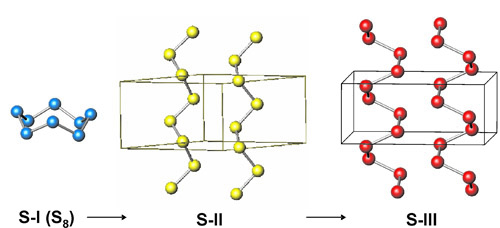
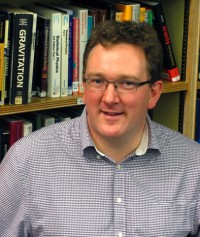
A spin-out company formed by staff at the Institute for Astronomy has secured a six-figure investment sum. The company will exploit patented software that was originally developed by the University to determine the age of stars. However the technology can be applied to many sectors where processing large amounts of data is routine, including seismic interpretation for oil and gas surveying, and fast image analysis for defence.
Blackford’s initial focus has been on medical imaging, where its technology can improve the diagnosis process for MRI and CT scans by automatically preparing images for radiologists.
Dr Ben Panter, CEO of Blackford Analysis, said: “The potential to save radiologist time is exciting. We already have concrete interest in further development from several significant industry players and there is similar potential in many other fields where large datasets require fast analysis.
“It’s been an exciting journey to get to this stage and we’re very pleased to secure this cash. Now we can really start to penetrate medical imaging and other markets.”
Blackford Analysis uses the MOPED algorithm, originally invented by Professor Alan Heavens of the Institute for Astronomy. Heavens and Panter’s work created a thousand-times increase in speed for the processing of galaxy spectra, and was used to determine the star formation history of the Universe.
Dr Panter said: “As datasets become larger, the cost of the hardware resources required to tackle them rocket and the case for MOPED is even more compelling. The MOPED algorithm vastly reduces that hardware cost, and the patented technology means that no other company in the world can do what Blackford Analysis can, solving emerging issues in an elegant and resourceful manner.”
A working demo of the product will be shown to potential customers at the Radiological Society of North America (RSNA) conference in November 2010.
Blackford Analysis is based at offices at The Royal Observatory on Blackford Hill.
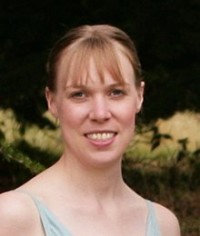
Dr Catherine Heymans, an Advanced Fellow of the Institute for Astronomy, has been named as one of the eight final candidates for the 2010 L’Oréal UNESCO ‘For Women In Science’ Fellowships.
The winner will be announced at an awards ceremony at the Royal Institution in London on 30 June 2010. Four outstanding female scientists will be awarded fellowships of £15,000 each.
Catherine’s research interests lie in Cosmology and Extragalactic Astronomy and she has been shortlisted for her efforts to determine how Dark Matter is distributed throughout the Universe. If successful, she plans to use her grant to support research travel.
The four winners will be selected by a panel of eminent scientists, chaired by Baroness Susan Greenfield.
The fellowships, now in their twelfth year internationally, promote the importance of ensuring greater participation of women in science by offering awards to outstanding female postdoctoral researchers.
The fellowships have been designed to provide practical help for the winners to undertake research in their chosen fields. Winners may choose to spend their fellowship on whatever they need to continue their research.
The awards are run in partnership with the UK National Commission for UNESCO, the Irish National Commission for UNESCO and the Royal Institution of Great Britain.
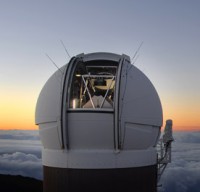
A new standard has been set in astronomy as the Pan-STARRS sky survey telescope begins scanning the skies nightly with the world's largest digital camera.
While searching for asteroids that threaten Earth, the PS1 telescope is also mapping the Universe and investigating its biggest mysteries: dark matter and dark energy.
Three UK universities are part of the international science consortium designing the telescope's science mission. Scientists from the University of Durham, University of Edinburgh and Queen's University Belfast are spearheading searches for supernovae, Near-Earth asteroids and the fundamental nature of the Universe.
Conceived and designed at the University of Hawaii Institute for Astronomy, the observatory sits atop the dormant volcano Haleakala.
With a 1.8-metre primary mirror, the PS1 telescope is modest in size, but it has an extraordinary field of view— seven times bigger than typical survey instruments.
Mounted on the back of the telescope is the refrigerator-sized 1400 megapixel camera that makes PS1 the world's most powerful survey telescope. This sensitive digital camera was regarded as an unreachable dream just a few years ago.
PS1 takes an image every 30 seconds, each one 200 times larger than a typical photograph. The wealth of astronomical information in these images can only be extracted by a complex computing endeavour that processes the images, identifies and catalogues astronomical objects, and classifies their attributes.
The completed archive will be several peta-bytes in size, enough to fill several thousand top-end PC hard disks.
"PS1 will generate the largest ever multi-coloured survey of the cosmos. Alongside supercomputer simulations of the Universe, these data will help us understand the life cycles of galaxies and, if we are very lucky, the nature of the mysterious dark matter and dark energy that control the evolution of our cosmos," said Prof. Carlos Frenk of Durham University, the UK's member on the Pan-STARRS board.
The Royal Observatory Edinburgh has a long history of survey astronomy. Prof. Alan Heavens of the University's Institute for Astronomy (IfA) said: "PS1 is a beautifully-designed instrument that will enable lots of different science, and IfA scientists will be playing key roles in many areas."
Prof. Heavens uses Einstein's theory of general relativity to understand how galaxies can bend light and act as cosmic lenses: "We co-lead the gravitational lensing programme, looking for signs of gravitational bending. This is an indicator of dark matter and dark energy, responsible for the dominant force driving the acceleration of the Universe.
"We are also looking at the clustering of galaxies to help us better understand the contents of the Universe and its past and future."
"There are still big challenges ahead for us. Pan-STARRS has immense potential for mapping the distribution of matter in the Universe, even the unseen dark matter. Our goal is to do this over the majority of the sky for the first time."
One novel aspect is the ability to track fast moving objects and exploding stars across nearly the whole sky.
Prof. Stephen Smartt of Queen's University and Chair of the Pan-STARSS Science Council said: "The huge camera lets us map about one sixth of the sky every month, in five different colours. We compare every image with one taken previously and try to track everything that either moves or flashes.
"Already we have discovered hundreds of supernovae, some of them the most luminous explosions known."
Pan-STARRS (Panoramic Survey Telescope & Rapid Response System) exploits the unique combination of superb observing sites and technical and scientific expertise available in Hawaii.
The project plans to build the full four-telescope Pan-STARRS array that will quadruple the light-gathering capability of PS1.
Funding for the development of the observing system has been provided by the U.S. Air Force.
The PS1 Surveys have been made possible through contributions of the PS1 Science Consortium (PS1SC): the Institute for Astronomy, the University of Hawaii; the Pan-STARRS Project Office; the Max-Planck Society and its participating institutes, the Max Planck Institute for Astronomy, Heidelberg, Germany and the Max Planck Institute for Extraterrestrial Physics, Garching, Germany; the Johns Hopkins University; the University of Durham; the University of Edinburgh; the Queen's University Belfast; the Harvard-Smithsonian Center for Astrophysics; the Los Cumbres Observatory Global Telescope Network, Inc.; and the National Central University of Taiwan.
Image gallery
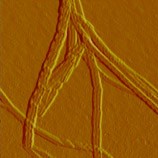
Schools of Physics and Chemistry combine to investigate the processes underlying conditions such as diabetes and cataracts.
The Biotechnology and Biological Sciences Research Council (BBSRC) has awarded £600,000 to an interdisciplinary collaboration between the School of Chemistry and the School of Physics and Astronomy.
The project, entitled “Biophysical dissection of protein nucleation using a combined experimental and computational approach”, will support research into the processes that drive diseases of ageing such as cataract and type-II diabetes.
It will employ close collaboration between experiment and simulation to better understand the earliest events in protein self-assembly at the single molecule level.
The normal self-assembly of proteins into structures containing many molecules is responsible for many biological functions and is essential to our well-being. Occasionally, due to a mutation or a change in environment, protein self-assembly takes place inappropriately. Small changes in very few molecules are sufficient to trigger “runaway” self-assembly. It is these changes, the triggering events, that are the focus for investigation.
Dr Cait MacPhee of the Institute for Condensed Matter and Complex Systems said: “Solving big problems needs a multidisciplinary approach. We’re applying the tools of physics and chemistry to an important biological phenomenon.
“Protein self-assembly doesn’t just cause disease, it also offers us the potential for new materials, new foodstuffs and new medicines. But to exploit it or prevent it we need to control it, and to control it we need to understand the earliest steps, molecule by molecule.”
The project takes advantage of an existing research programme with IBM, and a new multidisciplinary collaboration with the University of Oxford and the National Physical Laboratory in London. It will be led by the School’s Dr Cait MacPhee and Prof Jason Crain, and the School of Chemistry’s Dr Perdita Barran. Research techniques will include ion mobility mass spectrometry, spectroscopic methods and advanced computer simulations.
The award is part of the Research Councils UK “Lifelong health and wellbeing” programme. This cross-council strategic priority reflects the unprecedented demographic change underway in the UK. The proportion of young people is declining whilst that of older people is increasing. The Councils recognise that there are considerable benefits to the UK of having an active and healthy older population with potential economic, social, and health gains associated with healthy ageing and reducing dependency in later life.
The project is part of a wider pan-Scotland SUPA initiative in the area of Physics and Life Sciences (PALS). PALS has been identified by SUPA as the major opportunity for growth in physics research in Scotland, and this is reflected by the recent establishment of £10 million research theme across the eight SUPA universities. Dr Cait MacPhee currently acts as PALS Theme Leader.
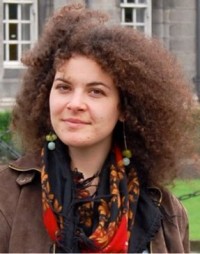
Edinburgh nuclear physicist Daria Sokhan has been awarded the 2009 Thomas Jefferson National Accelerator Facility (Jefferson Lab) thesis prize.
Daria wins a $2000 prize, a commemorative plaque to be placed in Jefferson Lab and the opportunity to present her thesis results at the annual Jefferson Lab user meeting. She shares this year’s award with Andrew Puckett from MIT.
The work by Daria which the award recognises will be a crucial part of the measurement programme aiming to accurately determine the properties of the excited states of the neutron and proton. These are complicated composite quantum systems comprising quarks and gluons interacting with each other and the vacuum.
Daria’s thesis work used the intense transversely polarised high-energy photon beam at Jefferson Lab to excite target neutrons into various excited states. A superconducting magnetic toroidal spectrometer (CLAS) was used to detect the decay products from the subsequent decay of the excited states a few trillion-trillionths of a second later.
As with any composite system, the excitation spectrum gives a window to test our understanding of the interactions and dynamics of its constituents. The energy associated with the interactions of the constituents of the proton and neutron are responsible for over 95 per cent of their mass (E=mc2) and therefore most of the mass of the visible universe.
Daria said: "I was delighted to receive the prize. It's in large part due to the great opportunity Edinburgh offered to work at such a fantastic facility abroad and of course the excellent supervision and support I received back here. Drinks all round!”
Her PhD supervisor Dan Watts said, “It’s great to see Daria’s work recognised in this way. Her results are a crucial missing piece in obtaining a better understanding of the dynamics of the nucleon. I would expect her to take the nuclear group out on the town using that generous award!"
Thomas Jefferson National Accelerator Facility
Jefferson Lab provides a continuous electron beam with energy up to 6 GeV. An upgrade to 12 GeV will start in 2011. The Lab is in Virginia, a few hours south of Washington DC, and it caters for around 1000 outside users per year.
About the award
The Thesis Prize is awarded to a graduate student who has carried out research related to Jefferson Lab science. It is awarded for the best graduate student thesis and includes a prize of $2,000 and a commemorative plaque placed at the lab. Four areas are considered in rating the submitted theses: the quality of the written dissertation; the student's contribution to the research; the work's impact on the field of physics; and service (how the work benefits Jefferson Lab or other experiments).
Image gallery
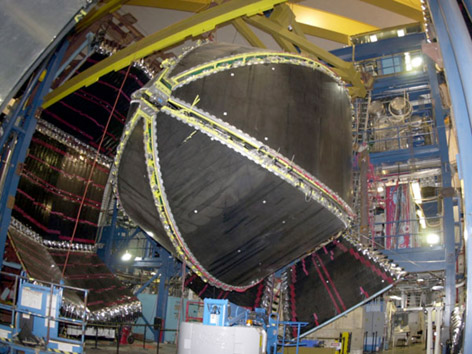
The CLAS detector used by Daria at Jefferson Lab.
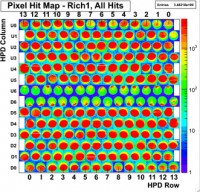
Physicists from the School of Physics & Astronomy have announced the first results from data produced by the Large Hadron Collider (LHC). This comes just weeks after the LHC started operating at a new beam energy of a record 7 trillion electron volts (TeV).
Speaking at the RICH10 conference, the University of Edinburgh’s Prof. Franz Muheim presented the first results from the Ring Imaging Cherenkov (RICH) Detectors of the LHCb Experiment with data taken at the LHC.
The RICH detectors are built to distinguish between different types of charged particles known as pions, kaons and protons. Their proper identification is crucial for measuring differences between particles and antiparticles. The detectors were built by a collaboration of 10 institutes from the UK, Italy and CERN.
The results represent an immense achievement – and a lot of hard work – over the last decade by the LHCb collaboration.
The Edinburgh team has made major contributions to the LHCb RICH detectors. Also to the development of distributed analyses techniques for the large LHC dataset on the Grid, including using ScotGrid and ECDF. The group has pioneered new ideas for searching for new physics beyond the Standard Model and have now commenced analysing LHCb data.
Prof. Franz Muheim says: “We are all thrilled to observe such an excellent RICH detector performance from day one.
“The LHCb experiment is located in the forward region, close to the beam pipe of a hadron collider, which is a very harsh environment and this makes these initial results a great achievement. We are all looking forward to the large data rates that the LHC will produce as it gradually increases the collision rate over the year."
“With the LHCb experiment at the LHC, we will explore uncharted territory and hopefully find something new, possibly unexpected."
“This is a fantastic time for science. Particle physics is one of the disciplines that excites school kids and motivates them to study physics, and we need a more scientifically literate workforce to tackle the challenges of the 21th century.”
The LHCb group in the School of Physics & Astronomy comprises: Prof. Franz Muheim, Prof. Pete Clarke, Prof. Steve Playfer, Dr. Stephan Eisenhardt, Dr. Greig Cowan, Dr. Yuehong Xie and Ph.D Students Rob Currie, Gemma Fardell, Conor Fitzpatrick, Young Min Kim, Ailsa Sparkes, Nick Styles, Ross Young and technician Andrew Main.
The results were presented at the 7th International Workshop on Ring Imaging Cherenkov detectors (RICH 2010), which runs from 3–7 May in Cassis , South of France. RICH2010 focuses on the present state of the art and the future developments in Cherenkov light imaging techniques for applications in High Energy Physics, Nuclear Physics and Astroparticle Physics.
See below for an explanation of the LHCb experiment and some first-hand accounts of the University’s involvement in LHCb and the RICH detectors.
The Hybrid Photon Detectors
Here some of the members of the LHCb group in the School of Physics & Astronomy describe their involvement with the experiment.
Ross Young
Ross Young is a PhD student who, at the RICH2010 conference, gave a presentation on results from operating the Hybrid Photon Detectors (HPDs) in the LHCb RICH counters.
“I was very fortunate that as part of my PhD studies I started a placement at CERN in October 2008, just after the installation of the HPDs into the RICH1 detector. Part of my work has been with the performance studies of HPDs - the light sensitive detectors of the RICH system.
“During the installation, columns of HPDs were mounted side-by-side to form 'bee-hive' arrays of HPDs (see Figure 2, below). Since then, we have been testing the performance of these arrays under a variety of different environments.
“As an example, we shine a continuous-wave laser on to the arrays to test the HPD response to light. Looking at the pixel hitmap of RICH1 (see Figure 1, above) you can notice, for every HPD under such illumination from laser, the projection of the circular photocathode image onto the pixel chip, in addition to other features such as shadowing. As well as carrying out analysis of the results, I have had the opportunity to carry out the runs myself in the control room.”
“The principle of a Ring Imaging Cherenkov detector is as follows: when a highly relativistic particle traverses through a medium at a very large speed exceeding the speed of light in the radiator, Cherenkov light is emitted at an angle which depends only on the speed of the particle and the refractive index of the medium.
“The Cherenkov photons are focused by spherical mirrors onto a ring on the photon detector arrays. The RICH detectors have recorded the first Cherenkov photon rings from collisions of the LHC beams.
“Figure 3 (below) shows a typical event. Each orange point depicts a single photon recorded by the HPDs. The sets of blue rings correspond to different particle hypotheses. One observes that photons lying typically on the ring with the largest radius identifies them as coming from a pion. Cherenkov photons from kaons or protons would lie on the smaller circles.”
Stephan Eisenhardt
Dr. Stephan Eisenhardt is coordinator of the University’s photodetector laboratory and he has been leading the testing of the HPDs in Edinburgh.
“The fully operational Ring Imaging Cherenkov Detectors of LHCb are a great achievement. The HPDs are a new technology. From idea and concept via design and development to commissioning they are a brain child of LHCb physicists.
“The HPDs provide an unprecedented noise-free sensitivity to enable particle identification. Never before has a detector been built which provides particle identification over such a wide momentum range.
“New concepts had to be developed for many aspects of it. Yet it is working from day one at a very high efficiency. This is testimony of the spirit of dedication and collaboration of so many people."
Ailsa Sparkes and Conor Fitzpatrick
Ailsa Sparkes and Conor Fitzpatrick are currently on a placement at CERN and take part in the day-to-day running of the RICH detectors.
Ailsa: “It is extremely exciting to be contributing to such an important experiment as LHCb at this pivotal time in particle physics.
“I didn't expect to be given direct control over the RICH detectors so soon into arriving here at CERN and it's a great experience. The atmosphere at CERN makes it a fun and lively place to work with potentially ground-breaking discoveries just around the corner.”
Conor: “This is very exciting. As a RICH Piquet I am responsible for the safe and reliable running of these detectors, a role I share with a number of physicists from universities and institutes throughout the world.
“It is humbling to be part of such a dedicated collaborative effort, and to share in the continued successes of our work."
Young Min Kim
Young Min Kim will present a poster at the RICH2010 conference, and explain his simulation studies of the performance expected from improved RICH photon detectors which will allow the LHCb experiment to operate at a ten times greater collision rate in the second half of the decade.
"It is a great honour to see my work on the HPDs integrated with that of everyone else to give fruit to the LHCb RICH detector system. A mix of fascination and pride swims in me knowing I'm contributing to detective work using the smallest traces of light as our clues."
The LHCb Experiment
The LHCb experiment aims to understand the matter-antimatter asymmetry in the Universe.
It is a real puzzle why the observable Universe consists almost entirely of matter. When the Universe was created in the Big Bang the amounts of matter and antimatter were identical, so the question is: “Where has all the antimatter gone?”
The Standard Model of Particle Physics provides a partial answer. The BaBar experiment at SLAC, Stanford, observed a large asymmetry between the decay rate of a neutral B meson (a particle containing a b-quark), which oscillates (transmutates) at a high frequency into its antiparticle and back, compared to the corresponding decay rate of the antiparticle into the same final state.
This phenomenon is known as CP violation in the interference between mixing and decay of B mesons, but the observed magnitude of CP violation is too low by a large factor of 1000 millions to explain the observed asymmetry.
The University of Edinburgh is a member of the BaBar experiment and the physicists proposing this mechanism as the origin of CP violation within the Standard Model were recognised with the Physics Nobel prize in 2008. By recreating at the LHC the conditions that existed a millionth of a millionth of a second after the Big Bang, the LHCb experiment is aiming to shed light on the cause of this matter-antimatter asymmetry which is at the basis of our existence.
Image gallery
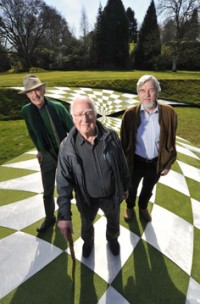
Prof. Peter Higgs, the Emeritus Professor whose theory of particle physics has dominated the discipline for decades, met Professor Rolf-Dieter Heuer, Director General of the European Organisation for Nuclear Research (Cern), and Dr Charles Jencks, landscape architect, at Dr Jencks' home, Portrack House, near Dumfries.
Cosmic garden
While at Portrack House, the guests enjoyed a tour of Dr Jencks’ Garden of Cosmic Speculation, which includes a sculpture of the standard model of physics.
The standard model is a theory which brings together fundamental elements of the science of physics. It includes the Higgs boson particle, which was first postulated by Professor Higgs when he was a researcher at the University in the 1960s.
Cern project
Dr Jencks is in discussions to design a garden at Cern, the physics laboratory near Geneva that is expected to uncover evidence of the theoretical particle.
Image gallery
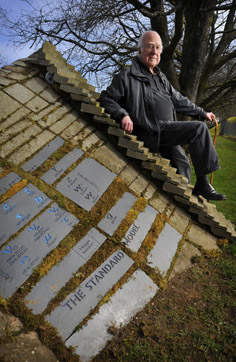
Prof. Peter Higgs and the sculpture of the standard model of physics.

